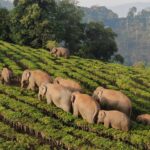The population of Northwest China’s Xinjiang Uygur Autonomous Region grew more than 18 percent over the past decade, the fourth fastest growth rate among the nation’s 31 provincial-level regions, and the populations of the Han and ethnic minorities have increased greatly with the latter accounting for more than 57 percent of the total, regional authorities announced on Monday.
The announcement came after some anti-China forces and media outlets used the population data from the seventh national census, which was released on May 13, as new ingredients to cook up their old lies of “genocide.”
As detailed demographic data, including the population of each ethnic group, birth rate and population by age group in the region, had not been released at that time, some media reports claimed that the rapid expansion of the Xinjiang Production and Construction Corps (XPCC) had contributed to the region’s 18.3 percent population growth in the past decade. Some even suspected that the Xinjiang regional government has falsified data on population.
The regional’s statistical bureau on Monday released a communiqué on the census data of Xinjiang from the seventh census, refuting the hype, rumors and vicious slander with detailed information and facts-based explanations.
As to why the regional population data from this census was inconsistent with that from 2010 to 2018 previously published by relevant research institutes, the official said that in line with international norms and practice, after obtaining the latest census data, relevant data for the years between the two censuses will be revised.
The 2021 China Statistical Abstract published the revised population data of all the provinces, regions and municipalities directly under the central government, which all showed adjustments, compared with the data published previously, the official said.
The population data for the Uygur ethnic group in 2018 published by Xinjiang, which was calculated by some research institutes based on relevant materials and sampling data, had some deviations and therefore needs revising according to the census results, the official explained, stressing that both Xinjiang’s total population and Uygur’s population have sustained steady growth.
The regional permanent population is 25,852,345, an increase of 18.52 percent compared with the sixth census in 2010. The average annual growth rate was 1.71 percent, which is higher than the national average, the communiqué shows.
Among the population of permanent residents in the region, 42.24 percent are Han ethnicity, 44.96 percent are Uygur ethnicity, and 12.8 percent are other ethnic minorities.
Specifically, compared with the sixth census, there was an increase of 2,174,000, or 24.86 percent, of Han ethnicity from the seventh census, of which the Han population who had moved from other provinces increased by 1,948,000. The population of ethnic minorities increased by 1,865,000, or 14.27 percent. Among the ethnic minorities, the Uygur population increased by 1,623,000, or 16.2 percent.
“The faster growth rate of the Han population in the region was the result of a large influx of migrant workers. Owing to the sustained social stability and rapid economic development in Xinjiang in recent years, there has been a substantial increase in the number of people who came to Xinjiang to invest and start businesses,” an official from the region said at Monday’s press conference.
The notorious Australian Strategic Policy Institute, the “right-wing, militaristic” think tank funded by the US and Western governments, mega-corporations and an eye-popping array of weapons manufacturers, also released a report in May, saying that Xinjiang is launching a “coercive campaign to drive down the indigenous birth-rate in Xinjiang.”
The ASPI report claimed that an “unprecedented and precipitous drop in official birth-rates” in Xinjiang from 2017 to 2019 was evidence of a campaign to cut “illegal births,” and the sharp decline in birth rate only happened in majority-indigenous counties.
Trends in world population development show that the higher the level of economic and social development, the stronger desire people tend to have for realizing their self-worth, healthy births and sound care. As a result, fertility rate and natural growth rate will decline accordingly.
In recent years, as Xinjiang has deepened its poverty alleviation efforts, the production and living conditions in impoverished areas in southern Xinjiang have improved continuously; urbanization has significantly accelerated and the urban population has continued to increase; and the education level and cultural quality of people of all ethnicities improved substantially. Accordingly, people’s attitude toward childbearing and upbringing has changed, with more and more people of all ethnicities voluntarily choosing to marry late and to have fewer children, the official said.
“As is shown by the figures, the natural growth rate of the regional permanent resident population, which is in line with the country’s changing trends, while starting to decline steadily in 2018, is still higher than the national level,” the official pointed out.
The natural growth rates of Xinjiang’s permanent resident population from 2010 to 2019 went from 10.71 ‰ to 3.69 ‰, while the national natural growth rates were from 4.79‰ in 2010 to 3.32 ‰ 2019.
China’s family planning policy has undergone an orderly, staggered rollout, which was initially launched in urban areas of eastern and central parts of the country before expanding to rural and border areas, with looser treatment being given to ethnic minorities compared with Han group.
Xinjiang regional regulations on family planning promulgated in 1992 began adopting a looser version of the policy for ethnic minorities: Urban Han couples could have one child, and rural couples could have two children, while their ethnic minority counterparts in urban and rural areas could have two and three children respectively.
In 2017, Xinjiang revised the regulation, stipulating that all ethnic groups had to observe a uniform family planning policy, which meant that urban couples could have two children and rural couples could have three.
“It’s clear that the family planning policy was applied to ethnic minorities 17 years later than the Han ethnicity and adopted a more lenient version than other provinces. For the next step, we will earnestly implement the central government’s decisions and arrangements on optimizing fertility, and organize and carry out the three-child policy to promote long-term balanced population development,” the official said.

From 2010 to 2020, total population in Xinjiang Uygur Autonomous Region consistently grew, and education and urbanization level continued to improve.Infographic: Huo Siyu/GT
Children have fun in “Dove Lane” in the old town Tuancheng of Hotan City, northwest China’s Xinjiang Uygur Autonomous Region, May 27, 2020.Photo: Xinhua



